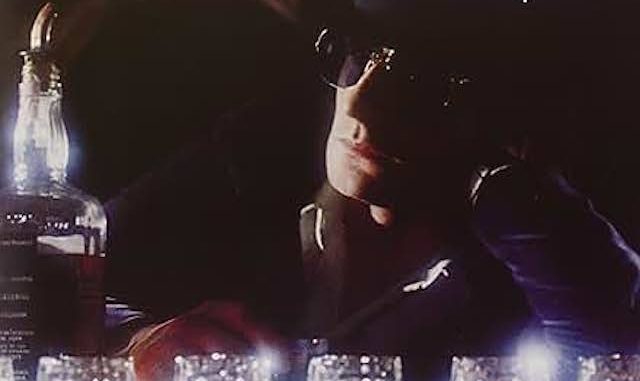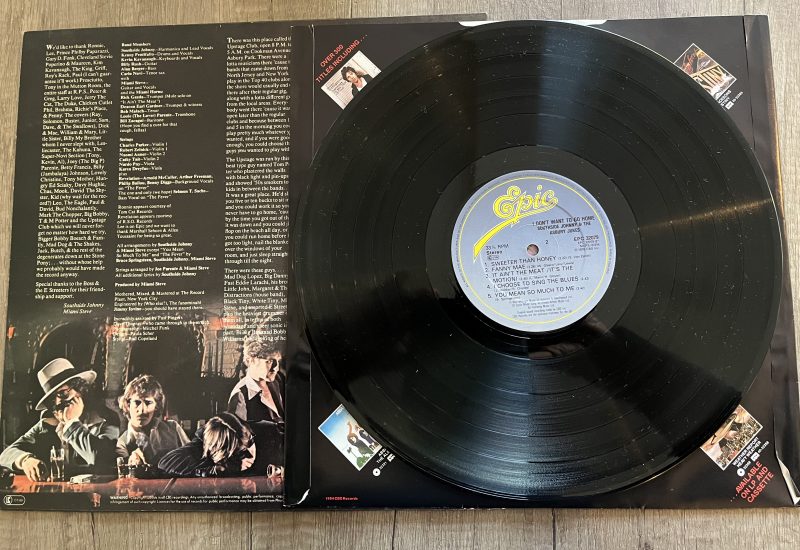
Before we start I have a confession to make. The mid seventies would coincide with my mid-teens and the start of a love affair with vinyl that over the following fifteen years would burn as bright as a shooting star across the midnight sky until the late eighties stumbled into the early nineties at which point the love affair ended and I finally succumbed to the charms of the compact disc and its bonus tracks. In truth it wasn’t a clean break as I continuously two-timed both, storing each collection in different rooms to try to hide my infidelity. Alas, things turned messy, as these things tend to do and my turntable finally refused to turn and rather than address the problem I chose the cowards way out, finally turning my back on my first love for the charms of the new. The following years would see a house move, with the vinyl boxed and banished to the loft never to see the light of day until now when I saw this new feature as an opportunity to rekindle an old flame. “Not so quick”, I hear you shout, “forgiveness is not so easily earned”, and that is the hard lesson that over the last couple of weeks I’ve come to learn. Thoughts of buying a new turntable as some sort of peace offering are still no more than thoughts after a trip to the loft confirmed my worst nightmares with another two decades of discarded and unloved belongings haphazardly stacked on top of the boxes of vinyl as precariously as a giant game of Jenga. Fortunately there was one box that appeared to be retrievable without bringing everything down on top of me and it is from that one solitary box that I have chosen my ‘Americana Vinyl Treasure’.
Back in those halcyon days of the mid seventies my burgeoning vinyl collection looked very much like that of most spotty faced fifteen year olds of the day, displaying a healthy mix of the giants of progressive and heavy rock. Bands such as Pink Floyd, Yes and Genesis sat proudly alongside the likes of Led Zeppelin, Deep Purple and Black Sabbath, but closer inspection would reveal the early shoots of what was to come with albums by Bob Dylan, Neil Young, Joni Mitchell and The Eagles jostling for position. In those days there was just one tv show that attempted to suppress the appetite of us music junkies and that was ‘Whispering’ Bob Harris and his ‘Old Grey Whistle Test’, which would be religiously devoured and then enthusiastically discussed at school the following day. It was through this medium that I first discovered a band that would change my musical landscape, help redirect my compass of travel, and up to this point supply my only tenuous claim to fame.
Southside Johnny and the Asbury Jukes grew out of the vibrant music scene that existed in New Jersey during the late sixties and early seventies around such legendary venues as ‘The Upstage Club’ and ‘The Stone Pony’. Here a collection of young musicians such as Garry Tallent, Danny Federici, David Sancious, Vine Lopez, Kevin Kavanaugh, Al Berger, John Lyon, Steve Van Zandt, oh and some guy called Bruce Springsteen would learn their chops in a myriad of short lived bands such as Dr Zoom and the Sonic Boom, The Friendly Enemies, Steel Mill, Sundance Blues Band and The Blackberry Booze Band. By the mid-seventies Lyon had taken on the stage name of Southside Johnny and this cream of New Jersey talent had splintered to form the backbone for two of the finest acts in the history of popular music, Bruce Springsteen & The E Street Band and Southside Johnny and the Asbury Jukes. One would go on to achieve global success the other to arguably become the most overlooked band in popular music history, while Van Zandt would succeed in being a major player in both outfits.
Released during the summer of 1976 and produced by Van Zandt with an equally young and wet behind the ears Jimmy Iovine as engineer, ‘I Don’t Want To Go Home’ was the first of a trilogy of albums the band would release during successive years, continuing with ‘This Time It’s For Real’ (1977) followed by ‘Heart Of Stone’ (1978) that critics would love and yet all three would fail to make any sizeable dent on the charts. The album comprises of ten tracks, three written by Van Zandt including the title track whilst Springsteen supplied two previously unreleased compositions, ‘The Fever’ and ‘You Mean So Much To Me’. It’s worth remembering at this point that Springsteen was banned from releasing any new material under his own name having become embroiled in a legal battle with former manager Mike Appel resulting in a three year hiatus between ‘Born To Run’ (1975) and ‘Darkness On The Edge Of Town’ (1978). This period was surely seen as a window of opportunity by Epic Records for their new signing to fill the void with the Springsteen connection being an obvious selling point, its relative failure as perplexing now as it was nearly fifty years ago.
Opening with the title track the album immediately states its ambition with Billy Rush’s driving guitar wrestling for the spotlight with the Miami Horns, the energy just bursting through the speakers while Southside’s soulful vocals, surely the finest interpreter of Springsteen’s songs, roars as he sings “as we reach up and touch the sky”, such that the floor beneath your feet truly shakes. And so it continues with a cover of Solomon Burke’s ‘Got To Get You Off My Mind’, to another Van Zandt number ‘How Come You Treat Me So Bad’ which see’s vocal contribution from the legendary Lee Dorsey. ‘The Fever’, one of the best songs Springsteen ever wrote has backing vocals from E Street Band sax player Clarence Clemons while none other than Ronnie Spector sings duet with Southside on the closing number ‘You Mean So Much To Me’. (It’s probably worth me pointing out at this point that this album is one of hundreds that I replaced on CD over the last thirty years and I am not simply reviewing it from memory).
In truth the following two albums are just as worthy of the highest praise, in fact ‘Heart Of Stone’ could rightly be seen as the pinnacle of their recording output and ripe for reviewing in the ‘Americana Classic Album’ series, but for me it was with their debut album that it all started, and in a way all changed. I have been lucky to see the band in their many different line-ups numerous times over the following five decades starting with Knebworth in 1979 where they were third on the bill to Led Zeppelin right through to an appearance in my home city of Lincoln at least ten years ago. And then of course there was that time in Nottingham back when the nineties were still in their infancy, with me up on stage singing with the Jukes whilst Southside glared from the front row, clearly not impressed. But that’s another story for another time and most definitely a different feature article.
Availability
As regularly happened with many of my vinyl purchases, the price sticker on the front stubbornly refused to be removed but it does at least show that I originally spent a colossal £3.49. Whilst many vinyl albums have proved to be a good long-term investment, alas this is not one of them, as a decent copy of the original release is only likely to set you back £2-£3 and the 1982 re-issue around the same. The album was also re-issued as a limited edition yellow vinyl release in 2013 and that sells for around the £12 mark. The first CD re-issue was in 1992. That and subsequent CD re-issues can be yours for around £3.



Apart from conceding a few years to you Graeme, a similar scenario emerges here. Loads (literally thousands) of vinyl (with a Linn Sondek LP12 no less!) gave way to CD. I skipped the loft phase and merely sold off the blackstuff. I now retain approx 50 or so of “the truly indispensable.” Anyway, Southside J…. Had it – let it go – got it back on CD …. along with all of his other stuff. I too have been lucky enough to see him 3 times (Norwich ‘91, Bury St Edmunds ‘13 & Holmfirth ‘19). However, if I read this right, your “tenuous claim to fame” was on stage actually singing with the Jukes!! Fantastic. I hope you stayed in tune.
I was at Holmfirth! what a venue!
Hi Alan. Yeah I think most of us that started their album collection during sixties and early seventies were very reluctant at first to accepted the CD format, but in the end all those bonus tracks that you just didn’t get with the vinyl finally proved too tempting. It was great to go back and revisit those early albums of Southside Johnny and the Ashbury Jukes even if they didn’t quite fit the remit for the feature, sorry Clint, as for singing in tune I think the look on Southside’s face, the image burnt on my memory forever, would suggest possibly not, lol.
Excellent piece, many thanks. Those albums are still a s exhilarating listen, though I tend to favour the production on “Hearts Of Stone”, and rate the guitar solo on the title track as a masterpiece.
We need to hear about Nottingham; your public demands it.
Hi Paul. Glad you enjoyed the article and would probably agree with you about “Heart Of Stone”, it is an absolute masterpiece. As for Nottingham, we might have to save that for a different series to tell that story. After all, a star has to keep his public wanting for more, lol.
Lovely article. Thank you. As with others the vinyl travels into CD’s and back again are the same for me….
Hi Tris, glad you enjoyed the article. As you say, I think many have made that journey from vinyl to CD and back again just lately, and great to hear from a fellow fan of the great Southside Johnny.